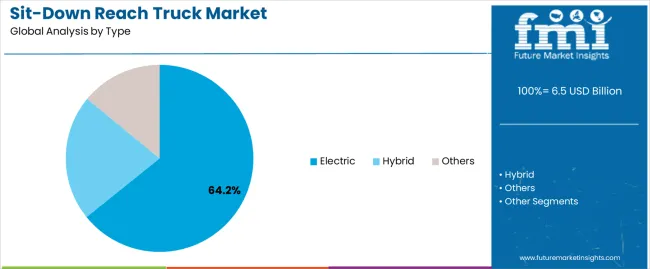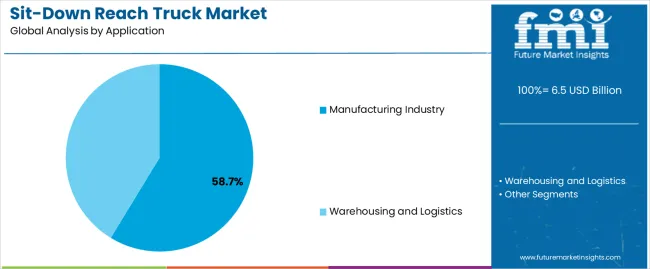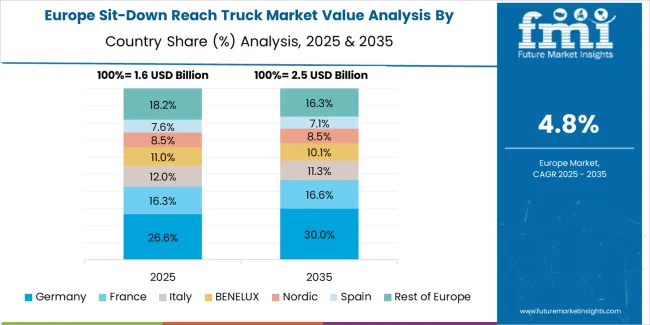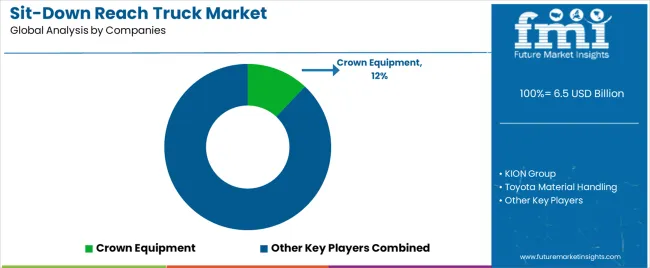The global sit-down reach truck market is valued at USD 6,511.7 million in 2025 and is slated to reach USD 10,913.8 million by 2035, recording an absolute increase of USD 4,402.1 million over the forecast period. This translates into a total growth of 67.6%, with the market forecast to expand at a compound annual growth rate (CAGR) of 5.3% between 2025 and 2035. The overall market size is expected to grow by approximately 1.68X during the same period, supported by increasing demand for automated warehouse solutions, growing adoption of electric material handling equipment across global markets, and rising preference for space-efficient storage systems across manufacturing and logistics applications.
The sit-down reach truck market represents a specialized segment of the global material handling equipment industry, characterized by steady demand across manufacturing, warehousing, and distribution channels. Market dynamics are influenced by changing warehouse automation requirements, growing emphasis on operational efficiency, and expanding cold storage facilities in emerging economies. Traditional forklift usage patterns are evolving as operators seek advanced reach capabilities and ergonomic designs that offer enhanced productivity and reduced operator fatigue.
Consumer behavior in the sit-down reach truck market reflects broader trends toward automated material handling solutions that provide both operational efficiency and enhanced safety features. The market benefits from the growing adoption of electric powertrains, which are recognized for their environmental advantages and reduced operating costs. Additionally, the versatility of sit-down reach trucks as both narrow-aisle handlers and high-reach equipment supports sustained demand across multiple industrial applications.
Regional deployment patterns vary significantly, with North American and European markets showing strong preference for electric variants, while Asian markets demonstrate increasing adoption of hybrid technologies alongside traditional internal combustion models. The industrial landscape continues to evolve with premium and technologically advanced reach truck products gaining market share in mainstream warehousing operations, reflecting operator willingness to invest in productivity improvements.
The competitive environment features established material handling manufacturers alongside emerging technology-focused companies that emphasize automation capabilities and fleet management systems. Manufacturing efficiency and supply chain optimization remain critical factors for market participants, particularly as component costs and raw material expenses continue to fluctuate. Distribution strategies increasingly emphasize service-oriented approaches that combine equipment sales with maintenance contracts through dealer networks.
Market consolidation trends indicate that larger manufacturers are acquiring specialized technology companies to enhance their automation portfolios and access advanced control systems. Private label development has gained momentum among regional distributors seeking to differentiate their offerings while maintaining competitive pricing structures. The emergence of connected reach truck solutions, including telematics and predictive maintenance capabilities, reflects changing operational priorities and creates new market opportunities for technology-integrated manufacturers. Manufacturing automation and quality control improvements enable consistent production scaling while maintaining the precision engineering characteristics that operators expect from established material handling brands.

Between 2025 and 2030, the sit-down reach truck market is projected to expand from USD 6,511.7 million to USD 8,400.5 million, resulting in a value increase of USD 1,888.8 million, which represents 42.9% of the total forecast growth for the decade. This phase of development will be shaped by increasing adoption of electric powertrains, rising demand for automated warehouse solutions, and growing emphasis on operator comfort with enhanced ergonomic characteristics. Equipment manufacturers are expanding their production capabilities to address the growing demand for narrow-aisle reach trucks, advanced battery technologies, and integrated fleet management systems across industrial channels.
| Metric | Value |
|---|---|
| Estimated Value (2025E) | USD 6,511.7 million |
| Forecast Value (2035F) | USD 10,913.8 million |
| Forecast CAGR (2025-2035) | 5.30% |
From 2030 to 2035, the market is forecast to grow from USD 8,400.5 million to USD 10,913.8 million, adding another USD 2,513.3 million, which constitutes 57.1% of the overall ten-year expansion. This period is expected to be characterized by the expansion of autonomous reach truck systems, the integration of advanced telematics solutions, and the development of specialized equipment with enhanced lifting capabilities and extended battery life. The growing adoption of Industry 4.0 technologies will drive demand for sit-down reach trucks with superior connectivity characteristics and compatibility with warehouse management systems across industrial operations.
Between 2020 and 2025, the sit-down reach truck market experienced steady growth, driven by increasing demand for warehouse automation solutions and growing recognition of electric material handling equipment as essential components for modern distribution centers across manufacturing and logistics applications. The market developed as operators recognized the potential for reach truck systems to provide both space optimization and operational efficiency while enabling precise load handling protocols. Technological advancement in battery technologies and ergonomic design began emphasizing the critical importance of maintaining productivity levels and operator comfort in demanding warehouse environments.
Market expansion is being supported by the increasing global demand for warehouse automation solutions and the corresponding need for space-efficient material handling systems that can provide superior reach capabilities and operational efficiency while enabling precise load positioning and extended operating cycles across various manufacturing and logistics applications. Modern warehouse operators and industrial specialists are increasingly focused on implementing automated handling solutions that can deliver enhanced productivity, minimize aisle width requirements, and provide consistent performance throughout complex distribution networks and diverse operational environments. Sit-down reach trucks' proven ability to deliver exceptional reach against narrow-aisle constraints, enable efficient high-rack operations, and support operator comfort protocols make them essential equipment for contemporary warehouse and manufacturing operations.
The growing emphasis on warehouse density optimization and electric powertrain adoption is driving demand for sit-down reach trucks that can support large-scale industrial requirements, improve space utilization outcomes, and enable sustainable material handling systems. Operator preference for equipment that combines effective reach capabilities with ergonomic design features and reduced environmental impact is creating opportunities for innovative reach truck implementations. The rising influence of e-commerce growth and cold storage expansion is also contributing to increased demand for sit-down reach trucks that can provide specialized handling capabilities, consistent performance across temperature variations, and reliable operation throughout extended operational periods.
The sit-down reach truck market is poised for steady growth and transformation. As operators across North America, Europe, Asia-Pacific, and emerging markets seek equipment that delivers exceptional reach performance, operational efficiency, and automated capabilities, sit-down reach trucks are gaining prominence not just as material handlers but as strategic enablers of warehouse optimization and productivity enhancement.
Rising automation adoption in Asia-Pacific and expanding cold storage initiatives globally amplify demand, while manufacturers are leveraging innovations in battery technologies, autonomous systems, and integrated telematics platforms.
Pathways like electric powertrains, autonomous capabilities, and specialized cold storage solutions promise strong margin uplift, especially in technology-focused operator segments. Geographic expansion and product diversification will capture volume, particularly where warehouse modernization and automation adoption are critical. Regulatory support around emission standards, safety requirements, and industrial automation give structural support.
The market is segmented by type, application, power source, lift capacity, distribution channel, end-use sector, and region. By type, the market is divided into electric, hybrid, and other categories. By application, it covers manufacturing industry and warehousing and logistic segments. By power source, the market includes battery electric, LPG, and diesel. By lift capacity, it comprises up to 1.5 tons, 1.5-2.5 tons, and above 2.5 tons. By distribution channel, it includes direct sales, dealers, and online platforms. By end-use sector, the market is categorized into automotive, food & beverage, retail, and others. Regionally, the market is divided into North America, Europe, East Asia, South Asia & Pacific, Latin America, and the Middle East & Africa.

The electric sit-down reach trucks segment is projected to account for 64.2% of the sit-down reach truck market in 2025, reaffirming its position as the leading type category. Warehouse operators and logistics companies increasingly utilize electric reach truck variants for their superior environmental characteristics when operating across diverse industrial applications, excellent operational efficiency properties, and widespread acceptance in applications ranging from cold storage to general warehousing operations. Electric reach truck technology's advanced battery systems and zero-emission capabilities directly address the operator requirements for sustainable material handling in complex industrial environments.
This type segment forms the foundation of modern warehouse automation patterns, as it represents the variant with the greatest operational efficiency and established performance credentials across multiple application categories and industrial segments. Manufacturer investments in battery technology development and charging infrastructure continue to strengthen adoption among warehouse operators and logistics providers. With operators prioritizing environmental compliance and operational cost reduction, electric sit-down reach trucks align with both sustainability objectives and performance expectations, making them the central component of comprehensive warehouse modernization strategies.

Manufacturing industry applications are projected to represent 58.7% of sit-down reach truck demand in 2025, underscoring their critical role as the primary deployment channel for reach truck systems across production facilities, component storage, and manufacturing support operations. Manufacturing operators prefer sit-down reach trucks for their exceptional precision characteristics, versatile handling options, and ability to manage heavy loads while ensuring consistent productivity throughout diverse production environments. Positioned as essential material handling solutions for modern manufacturing facilities, sit-down reach trucks offer both operational efficiency advantages and reliable performance benefits.
The segment is supported by continuous innovation in lift technologies and the growing availability of specialized configurations that enable diverse operational requirements with enhanced precision control and extended operational cycles. Additionally, manufacturing operators are investing in automated systems to support large-scale production requirements and operational optimization. As manufacturing complexity increases and precision handling requirements expand, manufacturing applications will continue to represent a major deployment market while supporting advanced automation utilization and production efficiency strategies.
The sit-down reach truck market is advancing steadily due to increasing demand for warehouse automation solutions and growing adoption of electric material handling systems that provide superior operational efficiency and environmental benefits while enabling precise load handling across diverse manufacturing and logistics applications. However, the market faces challenges, including high initial capital costs, complex maintenance requirements, and the need for specialized operator training and safety protocols. Innovation in battery technologies and autonomous systems continues to influence product development and market expansion patterns.
The growing adoption of automated warehouse systems, robotic integration platforms, and high-density storage solutions is enabling manufacturers to produce advanced sit-down reach truck systems with superior automation compatibility, enhanced precision control, and integrated connectivity functionalities. Advanced navigation systems provide improved operational accuracy while allowing more efficient workflow integration and reliable performance across various warehouse applications and operational conditions. Manufacturers are increasingly recognizing the competitive advantages of automation-ready capabilities for market differentiation and technology leadership.
Modern sit-down reach truck producers are incorporating lithium-ion battery systems, fast-charging capabilities, and comprehensive telematics platforms to enhance operational efficiency, enable predictive maintenance programs, and deliver data-driven solutions to industrial customers. These technologies improve equipment performance while enabling new operational opportunities, including extended runtime capabilities, reduced maintenance requirements, and enhanced fleet management characteristics. Advanced technology integration also allows manufacturers to support comprehensive industrial automation systems and market expansion beyond traditional material handling approaches.

| Country | CAGR (2025-2035) |
|---|---|
| China | 7.2% |
| India | 6.6% |
| Germany | 6.1% |
| Brazil | 5.6% |
| United States (USA) | 5.0% |
| United Kingdom (UK) | 4.5% |
| Japan | 4.0% |
The sit-down reach truck market is experiencing steady growth globally, with China leading at a 7.2% CAGR through 2035, driven by expanding manufacturing automation programs, growing warehouse modernization initiatives, and significant investment in electric material handling technology development. India follows at 6.6%, supported by increasing industrial infrastructure development, growing e-commerce sector expansion, and expanding modern warehouse construction.
Germany shows growth at 6.1%, emphasizing advanced automation integration and premium equipment development. Brazil records 5.6%, focusing on expanding manufacturing capabilities and logistics infrastructure modernization. The USA demonstrates 5.0% growth, prioritizing automation technology development and sustainable material handling trends. The UK exhibits 4.5% growth, emphasizing warehouse automation adoption and logistics optimization development. Japan shows 4.0% growth, supported by precision manufacturing initiatives and technology-focused operational patterns.
The report covers an in-depth analysis of 40+ countries, the top-performing countries are highlighted below.

Revenue from sit-down reach trucks in China is projected to exhibit strong growth with a CAGR of 7.2% through 2035, driven by expanding manufacturing automation programs and rapidly growing warehouse modernization supported by industrial development initiatives promoting advanced material handling equipment development. The country's strong position in manufacturing expansion and increasing investment in automated logistics infrastructure are creating substantial demand for electric reach truck systems. Major industrial operators and logistics facilities are establishing comprehensive automation capabilities to serve both domestic manufacturing demand and expanding export markets.
Revenue from sit-down reach trucks in India is expanding at a CAGR of 6.6%, supported by the country's growing manufacturing sector, expanding industrial infrastructure development, and increasing adoption of modern material handling equipment. The country's initiatives promoting manufacturing growth and growing warehouse construction are driving requirements for advanced reach truck systems. International suppliers and domestic manufacturers are establishing extensive production and distribution capabilities to address the growing demand for industrial equipment.
Revenue from sit-down reach trucks in Germany is expanding at a CAGR of 6.1%, supported by the country's advanced manufacturing heritage, strong emphasis on automation technology innovation, and robust demand for precision material handling equipment in industrial and logistics applications. The nation's mature manufacturing sector and technology-focused operations are driving sophisticated reach truck systems throughout the industrial sector. Leading manufacturers and automation providers are investing extensively in advanced technologies and autonomous systems to serve both domestic and international markets.
Revenue from sit-down reach trucks in Brazil is growing at a CAGR of 5.6%, driven by the country's expanding manufacturing sector, growing logistics modernization programs, and increasing investment in industrial material handling development. Brazil's large industrial base and commitment to infrastructure advancement are supporting demand for diverse reach truck solutions across multiple manufacturing segments. Manufacturers are establishing comprehensive distribution capabilities to serve the growing domestic market and expanding industrial opportunities.
Revenue from sit-down reach trucks in the USA is expanding at a CAGR of 5.0%, supported by the country's advanced manufacturing technology sector, strategic focus on sustainable industrial solutions, and established industrial equipment distribution capabilities. The USA's technology innovation leadership and automation integration are driving demand for specialized reach truck systems in advanced manufacturing, automated warehouses, and technology-focused applications. Manufacturers are investing in comprehensive technology development to serve both domestic specialty markets and international automation applications.
Revenue from sit-down reach trucks in the UK is growing at a CAGR of 4.5%, driven by the country's focus on warehouse automation advancement, emphasis on logistics innovation, and strong position in industrial technology development. The UK's established logistics automation capabilities and commitment to operational efficiency are supporting investment in advanced reach truck technologies throughout major industrial regions. Industry leaders are establishing comprehensive automation integration systems to serve domestic logistics modernization and advanced industrial applications.
Revenue from sit-down reach trucks in Japan is expanding at a CAGR of 4.0%, supported by the country's precision manufacturing initiatives, growing automation technology sector, and strategic emphasis on advanced industrial equipment development. Japan's advanced manufacturing capabilities and integrated production systems are driving demand for high-precision reach truck systems in advanced manufacturing, precision assembly, and technology-focused applications. Leading manufacturers are investing in specialized capabilities to serve the stringent requirements of precision-focused manufacturing and advanced industrial operations.

The sit-down reach truck market in Europe is projected to grow from USD 1,304.2 million in 2025 to USD 2,167.5 million by 2035, registering a CAGR of 5.2% over the forecast period. Germany is expected to maintain its leadership position with a 38.2% market share in 2025, declining slightly to 37.8% by 2035, supported by its strong manufacturing automation culture, sophisticated industrial equipment capabilities, and comprehensive logistics infrastructure serving diverse reach truck applications across Europe.
France follows with a 21.4% share in 2025, projected to reach 21.8% by 2035, driven by robust demand for automated material handling systems in industrial applications, premium logistics programs, and manufacturing facilities, combined with established industrial equipment infrastructure and automation expertise. The United Kingdom holds a 16.7% share in 2025, expected to reach 17.1% by 2035, supported by strong warehouse automation sector and growing logistics technology activities.
Italy commands a 12.3% share in 2025, projected to reach 12.6% by 2035, while Spain accounts for 7.8% in 2025, expected to reach 8.1% by 2035. The Netherlands maintains a 2.4% share in 2025, growing to 2.6% by 2035. The Rest of Europe region, including Nordic countries, Eastern Europe, Belgium, Poland, and other nations, is anticipated to maintain momentum, with its collective share moving from 1.2% to 0.0% by 2035, attributed to increasing manufacturing modernization in Eastern Europe and growing automation adoption in Nordic countries implementing advanced industrial programs.

The sit-down reach truck market is characterized by competition among established material handling manufacturers, specialized industrial equipment companies, and integrated automation solution providers. Companies are investing in battery technology research, automation integration, advanced control system development, and comprehensive equipment portfolios to deliver consistent, high-performance, and application-specific sit-down reach truck solutions. Innovation in electric powertrain systems, autonomous navigation integration, and operator comfort enhancement is central to strengthening market position and competitive advantage.
Crown Equipment leads the market with 12% share, offering comprehensive material handling solutions including advanced electric systems and precision control technologies with a focus on warehouse automation and industrial applications. KION Group provides specialized automation solutions with an emphasis on integrated systems and advanced technology platforms. Toyota Material Handling delivers comprehensive industrial equipment distribution with a focus on reliability platforms and large-scale operational services. Jungheinrich specializes in warehouse automation solutions and advanced reach truck systems for logistics applications. Anhui Heli focuses on manufacturing efficiency and cost-effective industrial solutions. Hyster-Yale offers traditional reach truck varieties with emphasis on heavy-duty applications and industrial durability.
| Item | Value |
|---|---|
| Quantitative Units | USD 6,511.7 million |
| Type | Electric; Hybrid; Others |
| Application | Manufacturing Industry; Warehousing and Logistics |
| Power Source | Battery Electric; LPG; Diesel |
| Lift Capacity | Up to 1.5 Tons; 1.5-2.5 Tons; Above 2.5 Tons |
| Distribution Channels | Direct Sales; Dealers; Online Platforms |
| End-Use Sector | Automotive; Food & Beverage; Retail; Others |
| Regions Covered | North America; Europe; East Asia; South Asia & Pacific; Latin America; Middle East & Africa |
| Countries Covered | China; India; Germany; Brazil; United States; United Kingdom; Japan; and 40+ additional countries |
| Key Companies Profiled | Crown Equipment; KION Group; Toyota Material Handling; Jungheinrich; Anhui Heli; Hyster-Yale |
| Additional Attributes | Dollar sales by type and application category; regional demand trends; competitive landscape; technological advancements in electric powertrain systems; automation integration development; battery technology innovation; industrial distribution integration |
The global sit-down reach truck market is estimated to be valued at USD 6.5 billion in 2025.
The market size for the sit-down reach truck market is projected to reach USD 10.9 billion by 2035.
The sit-down reach truck market is expected to grow at a 5.3% CAGR between 2025 and 2035.
The key product types in sit-down reach truck market are electric, hybrid and others.
In terms of application, manufacturing industry segment to command 58.7% share in the sit-down reach truck market in 2025.






Full Research Suite comprises of:
Market outlook & trends analysis
Interviews & case studies
Strategic recommendations
Vendor profiles & capabilities analysis
5-year forecasts
8 regions and 60+ country-level data splits
Market segment data splits
12 months of continuous data updates
DELIVERED AS:
PDF EXCEL ONLINE
Reachers Market Size and Share Forecast Outlook 2025 to 2035
Reach Stacker Market Analysis - Size, Share, and Forecast Outlook 2025 to 2035
Reach-In Freezers Market - Industry Demand & Market Growth 2025 to 2035
Reach-In Refrigerators Market – Commercial Cooling & Industry Outlook 2025 to 2035
Mast Reach Truck Market Forecast and Outlook 2025 to 2035
Blogger Outreach Software Market Size and Share Forecast Outlook 2025 to 2035
Automated Breach and Attack Simulation Market
Truck Mounted Cranes Market Size and Share Forecast Outlook 2025 to 2035
Trucks Market Size and Share Forecast Outlook 2025 to 2035
Truck Loader Crane Market Size and Share Forecast Outlook 2025 to 2035
Truck Market Analysis - Size, Share, and Forecast Outlook 2025 to 2035
Truck Racks Market Size and Share Forecast Outlook 2025 to 2035
Truck Bedliners Market Outlook- Trends & Forecast 2025 to 2035
Truck Mounted Knuckle Boom Cranes Market – Growth & Demand 2025 to 2035
Truck Platooning Market
Truck Mounted Concrete Mixer Market
Semi-Truck Market Size and Share Forecast Outlook 2025 to 2035
Hand Trucks And Dollies Market Size and Share Forecast Outlook 2025 to 2035
Food Truck Market Analysis - Size, Share, and Forecast Outlook 2025 to 2035
Dump Trucks Market Size and Share Forecast Outlook 2025 to 2035

Thank you!
You will receive an email from our Business Development Manager. Please be sure to check your SPAM/JUNK folder too.
Chat With
MaRIA